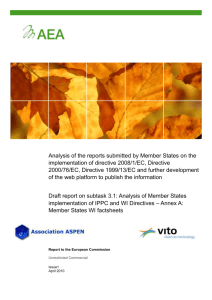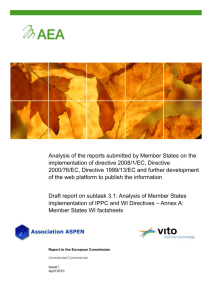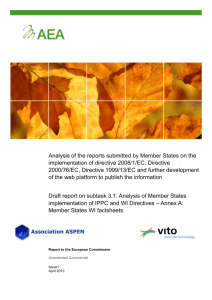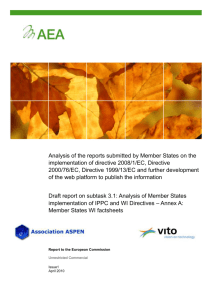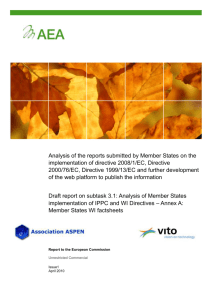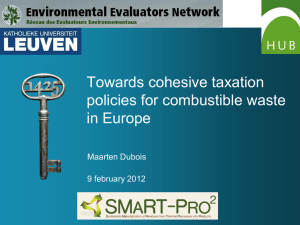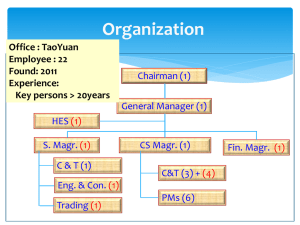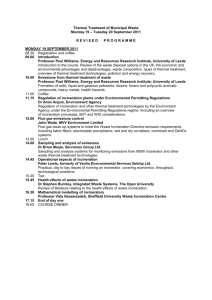MS factsheets WID BG
advertisement
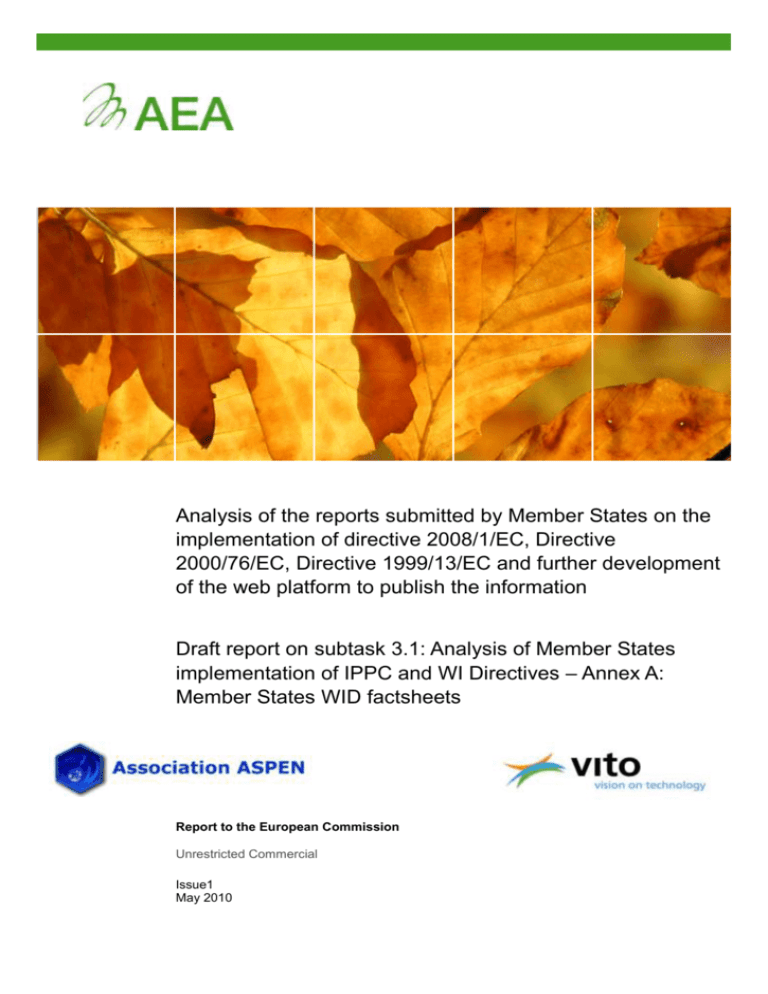
Analysis of the reports submitted by Member States on the implementation of directive 2008/1/EC, Directive 2000/76/EC, Directive 1999/13/EC and further development of the web platform to publish the information Draft report on subtask 3.1: Analysis of Member States implementation of IPPC and WI Directives – Annex A: Member States WID factsheets Report to the European Commission Unrestricted Commercial Issue1 May 2010 Unrestricted Analysis of the reports submitted by the Member States Framework contract No. ENV/C.4/FRA/2007/0011 Draft Report Title Analysis of the reports submitted by the Member States and the further development of the web platform to publish the information Customer European Commission Customer reference ANV.C.4/FRA/2007/0011 Confidentiality, copyright and reproduction Unrestricted File reference Reference number Marie Leverton AEA Gemini Building Harwell IBC Didcot OX110QR UK t: 0870 190 2817 f: 0870 190 5545 AEA is a business name of AEA Technology plc AEA is certificated to ISO9001 and ISO14001 Author Name Approved by Name Liesbet Goovaerts (VITO) Katrijn Alaerts (VITO Ive Vanderreydt (VITO) Signature Date AEA Energy & Environment iii Unrestricted Analysis of the reports submitted by the Member States Framework contract No. ENV/C.4/FRA/2007/0011 Draft Report Table of contents Annex A iv 5 AEA Unrestricted Analysis of the reports submitted by the Member States Framework contract No. ENV/C.4/FRA/2007/0011 Draft Report Annex A Annex A sets out the detailed overviews of the Member States responses to the questionnaire. For each Member State a individual fact sheet is drafted containing: - The main text given in the response to each qualitative question by means of a short summary. This short summary presents the most relevant information provided by the MS in relation to each question. The questions are structured using the 6 main categories, used in the reporting tool. The qualitative questions are further split into subcategories providing an overview of specific practical approach and experiences of the Member States for each of the main categories. - Presentation of the Member States quantitative data in tables; - The completeness table, which indicates the degree to which the answers comply with the requirements of the questionnaire. The method described in the main report is used; - A summary on the status of implementation. This summary describes whether or not all requirements are implemented into a functional and effective practical systems. These fact sheets were presented to the Member States for approval. All comments, clarifications and additional information provided by the Member States were taken into account. These fact sheets are used as the basis for the analysis made in previous chapters. AEA Group 5 Unrestricted Analysis of the reports submitted by the Member States Framework contract No. ENV/C.4/FRA/2007/0011 Draft Report BULGARIA Overview of the answers The table below presents the detailed analysis of Bulgaria’s responses to each question of the questionnaire, by means of a short summary or standardised answer where appropriate. Comments regarding the adequacy of the answers in relation to the requirements of the questionnaire are added where necessary. AEA Group 6 Unrestricted Analysis of the reports submitted by the Member States Framework contract No. ENV/C.4/FRA/2007/0011 Draft Report Table 1: Bulgaria – overview of the answers Main category Question number – sub question reporting tool Subcategory: approach or experiences Summary of MS response Comments Question (Q) 1 Category: DEFINITIONS Subcategory: Specific Member States approach NO related questions asked Subcategory: Experiences of Member States 1.1 2 Please describe any problems with the definitions given in Article 3 identified when transposing and implementing the Directive? - Waste Hazardous waste Mixed municipal waste Incineration plant Co-incineration plant Existing incineration or co-incineration plant This definition is hardly applicable to Bulgaria since the time limits set out in the definition have expired prior to transposition of Directive into national law (Regulation No. 6 of 28 July 2004 on the conditions and the requirements for construction and operation of installations for incineration or co-incineration of waste). In this context, it is assumed that an existing incineration and co-incineration plant is any incineration or coincineration plant put into operation prior to the date of entry into force of the Regulation. - Nominal capacity Emission Emission limit value Dioxins and furans Operator Permit Residue - Category: NUMBER OF INSTALLATIONS/PERMITS/WASTE (CO)-INCINERATED Subcategory: Specific Member States approach NO related questions asked Subcategory: Experiences of Member States 7 Unrestricted Analysis of the reports submitted by the Member States Framework contract No. ENV/C.4/FRA/2007/0011 Draft Report Question number – sub question reporting tool Main category Subcategory: approach or experiences Summary of MS response Comments Question (Q) 2.1 Please give information on number of installations, permits and permitted capacities that fall within the scope of the Directive See Table 2 below 2.2 Have any mobile plants received permits under this Directive Please specify. No 2.3 Please give information on the waste that has been co-incinerated For cement kilns - - - - waste oils: plastics: textiles: RDF: EU waste catalogue code: 130205*, 130503* hazardous/non-hazardous: hazardous amount (tonnes/year): 14 EU waste catalogue code: 070213, 070299, 150102,191204, 200139 hazardous/non-hazardous: hazardous and non-hazardous amount(tonnes/year): 207 EU waste catalogue code: 040222, 150202, 150203 hazardous/non-hazardous: hazardous and non-hazardous amount: 18 EU waste catalogue code: 191210 hazardous/non-hazardous: - other (please specify): amount(tonnes/year): 4520 EU waste catalogue code: 150101, 160103, 160306 Hazardous/non-hazardous not specified. hazardous/non-hazardous: AEA Group amount(tonnes/year): 11 662 remarks: paper and cardboard (150101) - 4.5 tonnes/ year; tyres (160103) - 4592 tonnes/year; meat-and-bone meal from rendering (160306) - 7070 tonnes/year 8 Unrestricted Analysis of the reports submitted by the Member States Framework contract No. ENV/C.4/FRA/2007/0011 Draft Report Main category Question number – sub question reporting tool Subcategory: approach or experiences 2.4 Question (Q) How many co-incineration plants are subject to the emission limits provided in Annex V of the Directive (i.e. where co-incineration of untreated municipal waste is undertaken or more than 40 % of the heat release results from the combustion of hazardous waste)? Remarks: 3 Summary of MS response Comments 0 In the integrated permits issued to the four co-incinerating cement plants specified in 3.6.2, co-incineration of untreated municipal waste is not permitted to take place, and the heat generated from the combustion of hazardous waste should not be more than 40 % of the resulting total heat release. Category: PERMIT Subcategory: Specific Member States approach 3.1 What provisions are made within the permitting process for: No information is provided on how these quantities, categories, flows, ranges of calorific values and restrictions set out in the permit are delineated. 3.1.1 Identifying the quantities and categories of hazardous waste that may be treated 3.1.2 The minimum and maximum flows of hazardous wastes to be treated 3.1.3 The range of calorific values of hazardous wastes permitted - their lowest and maximum calorific values; 3.1.4 Restrictions on the content of pollutants e.g; PCB, PCP, chlorine, fluorine, sulphur, heavy metals - their maximum contents of pollutants, e.g. PCB, PCP, chlorine, fluorine, sulphur, heavy metals. For incineration plants, what measures are in place (in addition to the report requested under Article12(2), if any) to ensure that plants are designed, equipped, built and operated to so that the emission limit values (as set out in Annex V of the Directive) are not exceeded? In national legislation (Chapter Four of Regulation No. 6 of 28 July 2004), the conditions and the requirements for the design, construction and operation of waste incineration and co-incineration plants are laid down. 3.4 In national legislation (Art. 5 of Regulation No. 6 of 28 July 2004) it is stated that permits for waste-related activities and integrated permits for waste incineration and co-incineration should specify the type and amounts of waste allowed for treatment using the codes listed in national waste classification legislation (Annex 1 of Ordinance No. 3 of 2004) For each permitted type of hazardous waste, the following should be specified: the minimum and maximum mass flows; - Procedures for environmental impact assessment as well as for the issuing of a permit have been set up. 9 Unrestricted Analysis of the reports submitted by the Member States Framework contract No. ENV/C.4/FRA/2007/0011 Draft Report Question number – sub question reporting tool Main category Subcategory: approach or experiences Summary of MS response Comments Question (Q) - The plants have been assessed and conditions have been set to ensure that the established emission limit values will not be exceeded when operating the plants. The plant operators are responsible for making continuous and periodic measurements of the emissions of polluting substances into the air, which are periodically verified on site by the competent authorities. In addition, the competent authorities carry out periodic control measurements of these emissions. See answer to question 3.4 3.5 For co-incineration plants, what measures are in place (in addition to the report requested under Article12 (2), if any) to ensure that plants are designed, equipped, built and operated to so that the emission limit values (as set out in Annex II of the Directive) are not exceeded? 3.7 For releases to air from incineration and coincineration plants, have emission limit values additional to those given in Annex II or Annex V, as appropriate, been set? No 3.8 How are emission limit values for discharges of waste water from flue gas cleaning equipment to the aquatic environment determined? Identical to Annex IV Remarks The facilities specified in this report have no wet gas purification and therefore do not generate waste water from the cleaning of exhaust gases. Still, the emission limit values for dangerous and hazardous substances in waste water from gas purification are specified in national legislation (Chapter Six of Regulation No. 6 of 28 July 2004 ). Have emission limit values been set for pollutants discharged to water, in addition to the pollutants specified in Annex IV? No What operational control parameters are set within the permitting process for waste water discharges? pH Temperature Flow Remarks National legislation (Art. 28 and 29 of Regulation No. 6 of 28 July 2004) determines the points for which the relevant individual emission limit values apply. In these points the analyses of the waste water from the cleaning of exhaust gases are carried out, inter alia continuous measurements of: pH, temperature and flow other operational parameters necessary in view of the specific technical 3.9 3.10 AEA Group All analyses to be carried out on the waste water from the cleaning of exhaust gases are specified in the original answer. 10 Unrestricted Analysis of the reports submitted by the Member States Framework contract No. ENV/C.4/FRA/2007/0011 Draft Report Question number – sub question reporting tool Main category Subcategory: approach or experiences Summary of MS response Comments Question (Q) conditions in the treatment facility. 3.11 What provisions have been made to ensure protection of soil, surface waters or groundwater in accordance with Article 8(7)? The provisions of national legislation (Art. 31(1) of Regulation No. 6 of 28 July 2004) lay down the requirements for ensuring adequate protection of soil, surface waters or groundwater. 3.12 What criteria are used to ensure that storage capacity is adequate for waters to be tested and treated before discharge where necessary? National legislation (Art. 31(2) and (3) of Regulation No. 6 of 28 July 2004) states that: storage capacity must be provided for contaminated rainwater run-off or contaminated water arising from spillage or fire-fighting operations. the storage capacity and the residence time of waste water in the tanks should be adequate to ensure that such water can be tested and treated before discharge where necessary. For determining storage capacity and the residence time account is taken of: o the best practices o the capacity of the waste water treatment facility o the quantities of water intended for fire-fighting purposes in accordance with the emergency plan of the facility o the maximum rainfalls in the region of the facility site. 3.13 What provisions in general have been made to minimize the quantities and harmfulness of residues resulting from incineration or coincineration plants? National legislation (Chapter Seven of Regulation No. 6 of 28 July 2004) sets out the general measures for management of the residues resulting from incineration and coincineration plants. The operators of incineration and co-incineration plants are required to maintain the incineration process within optimal limits in order to ensure that the slag and bottom ashes total organic carbon content is less than 3 %. Transport and intermediate storage of residues in the form of dust resulting from the operation of incineration plants, as takes place in closed containers or polyethylene big-bags to avoid spreading. Harmful residues from incineration are pre-treated prior to disposal to a landfill to meet the criteria for the relevant landfill class. This pre-treatment includes solidifying of the residue by its mixing with cement to minimize the mobility of dangerous substances in the residues. In the case of the co-incineration plants the generated residues are recovered as an inseparable part of the cement clinker produced. 3.14 Are the requirements of the permit for the measurement of pollutants to air and process operation parameters identical to those set out in Article 11(2)? Yes No information is provided on recycling of the residues from incineration plants. 11 Unrestricted Analysis of the reports submitted by the Member States Framework contract No. ENV/C.4/FRA/2007/0011 Draft Report Question number – sub question reporting tool 3.15 3.16 Main category Subcategory: approach or experiences Summary of MS response Question (Q) Are the requirements of the permit for the measurement of pollutants to water identical to those set out in Article 11(14-15)? Yes What provisions are made within the permitting process, as regards to air emissions, to ensure compliance with the provisions of 3.16.1 Article 11 paragraph 8? National legislation (Chapter Nine of Regulation No. 6 of 28 July 2004) specifies the conditions and the requirements for construction and operation of installations for incineration or co-incineration of waste. Within the procedure for the issuance of permits, the relevant conditions are set, which oblige the operator to carry out the measurements to comply with this legislation. 3.16.2 Article 11 paragraph 9? National legislation (Chapter Nine of Regulation No. 6 of 28 July 2004) specifies the conditions and the requirements for construction and operation of installations for incineration or co-incineration of waste. Within the procedure for the issuance of permits, the relevant conditions are set, which oblige the operator to carry out the measurements to comply with this legislation. - - - All measurement results are recorded, processed and presented to the competent authority in the form of a report in order to enable the competent authority to verify compliance with the permitted operating conditions and the emission limit values established by this legislation. Operators are obliged to ensure a periodic calibration of the measurement equipment. This calibration is carried out by a specialised external company, and the results are submitted to the competent control authorities. The operators are obliged to present to the competent control authorities monthly and annual reports on the measurements carried out by them. 3.16.3 Article 11 paragraph 11 ? See answer to question 3.16.1 3.16.4 Article 11 paragraph 12? See answer to question 3.16.1 What provisions are made within the permitting process, as regards to water emissions, to ensure compliance with the provisions of Article 11 paragraph 9 See answer to question 3.16.2 3.17 Comments AEA Group No further information is provided on the guidance concerning the location of the measurement points. 12 Unrestricted Analysis of the reports submitted by the Member States Framework contract No. ENV/C.4/FRA/2007/0011 Draft Report Question number – sub question reporting tool 3.18 Main category Subcategory: approach or experiences Summary of MS response Question (Q) What compliance regime is applied for emissions to air and water according to Article 11 paragraphs 10 and 16, respectively? A full compliance regime is applied. Comments For air: 3.19 Option box: Identical to Article 11(10)/More stringent compliance regime For water: identical Option box: Identical to Article 11(16)/More stringent compliance regime identical Please describe any official guidance that has been developed to determine average emission data in accordance with article 11, paragraph 11? National legislation (Instruction No. 1 of 3 July 2003) describes the procedures for producing validated daily average emission data. If available, provide the reference or weblink. 3.20 What are the procedures for informing the competent authority in the event of breach of an emission limit? National legislation (Art. 53 of Regulation No. 6 of 28 July 2004) requires that when the results of the measurements indicate that the emission limit values have been exceeded, the operators inform the competent authorities in writing of the recorded exceeding values without delay. Subcategory: Experiences of Member States 3.2 What wastes have been considered to be ‘inappropriate’ for representative sampling? Type: biological waste, infectious waste Reasoning: National legislation (Art. 9(6) of Regulation No. 6 of 28 July 2004) states that the requirements for taking representative samples do not apply to biological waste and waste classified as infectious. 13 Unrestricted Analysis of the reports submitted by the Member States Framework contract No. ENV/C.4/FRA/2007/0011 Draft Report Main category Question number – sub question reporting tool Subcategory: approach or experiences 3.3 Question (Q) With regard to the furnace gas residence times and temperatures laid out in Article 6(1) and Article 6 (2): have any exemptions from the operating conditions been granted in accordance with Article 6(4)? Summary of MS response No 3.6 For cement kilns co-incinerating waste, have any exemptions from the emission limits for NOx, dust, SO2 or TOC been granted in accordance with Annex II.1? Yes 3.6.1 If yes, how many exemptions have been granted? 4 3.6.2 If yes, where these data are available, please describe the reasoning for granting the derogation(s) for each case (optional) See Table 3 below 4 Comments Category: Public participation Subcategory: Specific Member States approach 4.1 What arrangements are made to ensure public participation in the permitting process? Remarks: - type of permit No information provided - public availability of the permit application period that the public is enable to comment public availability of the final decision on the permit application No information provided - AEA Group Within the procedure for the issuance of integrated permits (Article 122a(5) of the Environmental protection Act), the competent authority acting jointly with the municipalities concerned : announce the application ensure equal access to the application for the persons concerned, incl. the persons in the States affected by the operation of the facility in case of transboundary impact, during the course of one month. take into consideration the opinions submitted throughout the period of public access in the process of issuance of the permits. No information provided No information provided 14 Unrestricted Analysis of the reports submitted by the Member States Framework contract No. ENV/C.4/FRA/2007/0011 Draft Report Question number – sub question reporting tool 4.2 Main category Subcategory: approach or experiences Summary of MS response Comments Question (Q) With regard to the availability of information throughout the permitting process: 4.2.1 Is there any information related to environmental aspects not publicly available on the application, decision process and subsequent permit? No 4.2.2 Where these data are available, please specify whether this information is available free of charge (optional) Yes 4.3 For incineration plants and co-incineration plants with a nominal capacity of two tonnes or more per hour, what provisions are made to require an operator to submit an annual report on the functioning and monitoring of the plant to the competent authority? National legislation (Art. 46 of Regulation No. 6 of 28 July 2004, Art.125(1)of the Environmental Protection Act) requires that: all measurement results are recorded, processed and presented to the competent authority in the form of a report. the plant operator prepares and submits an annual report on the implementation of the activities for which an integrated permit has been granted In the legislative framework regulating the environment, penal provisions are provided for operators failing to submit an annual report. 4.4 What information are these Annual Reports required to contain? Remarks - Account of the running of the process Emissions into air compared to standards set in the Directive Emissions into water compared to standards set in the Directive Capacity of the installation Type of the installation (incineration or co-incineration) Types of waste that are incinerated The annual report contains : An introductory part with data about the operator and the plant An environmental management system Information on meeting the requirements for efficient use of resources Use of water Use of energy Use of raw materials, auxiliary materials and fuels Storage of raw materials, auxiliary materials and products Results of self-monitoring as: o A report under the E-PRTR o Emissions of harmful substances into the air o Emissions of harmful and dangerous substances in waste water o Waste management o Implementation of specific permit conditions relating to noise o Protection of soil and groundwater from pollution o A report on an investment programme for enforcement of 15 Unrestricted Analysis of the reports submitted by the Member States Framework contract No. ENV/C.4/FRA/2007/0011 Draft Report Main category Question number – sub question reporting tool Subcategory: approach or experiences Summary of MS response Comments Question (Q) o o 4.5 4.6 How are the annual reports made available to the public? All annual reports are available through the internet All annual reports are available from the competent authority upon request. Remarks: The Executive Environmental Agency maintains a public register of the results of the emissions monitoring provided for in the integrated permits. These results are published on the web page of the Executive Environmental Agency: http://nfpbg.eionet.eu.int/ncesd/bul/IPPC/ip-kom/ip-doc.html The list of these plants is officially published by the competent authority(according to Art. 59 of Regulation No. 6 of 28 July 2004) For incineration or co-incineration plants with a nominal capacity of less than two tonnes per hour, how are these plants publicly identified? Subcategory: Experiences of Member States 5 compliance with the conditions of the integrated permit Cessation of the operation of installations or parts of installations Accidents, complaints and objections relating to the environment. NO related questions asked Category: Abnormal operation of installations Subcategory: Specific Member States approach 5.1 What provisions are made within a permit to control the period of operation of an incineration or co-incineration plant during abnormal operation (i.e. stoppages, disturbances or failure of abatement or monitoring equipment)? 5.2 For incineration and co-incineration processes what are the maximum permissible periods of operation during abnormal operation (i.e. before the plant must shut down)? Remarks AEA Group In the integrated permits conditions relating to intermediate and abnormal operation are laid down, in which it is specified how to control the plant operation in the event of a deviation from the normal operating conditions. The operator of the plants is obliged to apply a monitoring plan in abnormal operating conditions, which should include, as a minimum: the nature quantities duration in time of the abnormal operation emissions the method for their measurement and control. Summarized results of the monitoring in abnormal operation of the plants are submitted as a part of the Annual Environmental Report. Information provided allows not to check if the conditions laid down in the permit cover all periods of abnormal operation. The provisions in case of deviations from the normal operating conditions of the incineration and co-incineration plants are laid down in national legislation (Chapter Ten of Regulation 6 of 28 July 2004). In the integrated permits conditions are laid down, which oblige the operators of the plants to stop incinerating waste when for a period of more than 4 hours uninterrupted the emission limit values set in the integrated permit 16 Unrestricted Analysis of the reports submitted by the Member States Framework contract No. ENV/C.4/FRA/2007/0011 Draft Report Main category Question number – sub question reporting tool Subcategory: approach or experiences Summary of MS response Comments Question (Q) are exceeded. After eliminating the causes for exceeding the emission limit values, a resumption of this activity is allowable. The cumulative duration of the periods of operation of the plant in abnormal operating conditions should be less than 60 hours/year, irrespective of the number of periods of excessive emission limit values. The 60-hour restriction applies to all kilns of the entire plant which are linked to one single flue gas cleaning device. 6 Maximum permissible period with exceedence of emission limit values 4 hours Maximum cumulative duration of periods exceeding ELV over one year 60 hours Subcategory: Experiences of Member States NO related questions asked Category: Other Subcategory: Specific Member States approach NO related questions asked Subcategory: Experiences of Member States 6.1 6.1.1 What information, if any, do you have to suggest that the Directive should be amended with regards to Articles 10 - 6.1.2 Articles 11 - 6.1.3 Articles 13 - 6.1.4 Annex I - 6.1.5 Annex III - 6.1.6 Other (optional) - 17 Unrestricted Analysis of the reports submitted by the Member States Framework contract No. ENV/C.4/FRA/2007/0011 Draft Report Member State quantitative data Table 2: Answer to question 2.1 Requested information existing1 new total Number of installations within the scope of the Directive 0 7 0 Number of permits issued 0 7 0 Number of permits to be issued 0 0 0 - - - 0 7 0 Total permitted capacities of waste throughput, if available (optional) (tonnes/year) Number of plants that recover heat generated by the incineration process 1 Existing plants are as defined in article 3 paragraph 6, new plants are all others AEA Group 18 Unrestricted Analysis of the reports submitted by the Member States Framework contract No. ENV/C.4/FRA/2007/0011 Draft Report Table 3: Answer to question 3.6.2 New/Existing Parameter Limit value NOx - 1200 mg/Nm3 from 1 January 2007 to 31 December 2007, in case of incineration of less than 3 tonnes of waste per hour for each kiln - 800 mg/Nm3 from 1 January 2007 to 31 December 2007, in case of incineration of more than 3 tonnes of waste per hour for each kiln - 800 mg/Nm3 from 1 January 2008 Existing Dust SO2 TOC NOx Existing Dust SO2 NOx - 50 mg/Nm3 from 1 January 2007 to 31 December 2007, in case of incineration of less than 3 tonnes of waste per hour for each kiln - 30 mg/Nm3 from 1 January 2007 to 31 December 2007, in case of incineration of more than 3 tonnes of waste per hour for each kiln - 30 mg/Nm3 from 1 January 2008. Reasoning for granting the derogation (only for TOC and SO2) The authorised exemptions for SO2 and TOC are on the basis of the main raw materials (marl and limestone) used in the production of cement clinker. In the process of the issuance of an integrated permit, the competent authority has requested the operator to provide evidence that the SO2 and TOC emissions are not as a result of incineration of waste but of the raw materials used. The measurement results during waste incineration and during the conventional process are one and the same. Moreover, it should be taken in consideration that the emission limit values set for SO2 and TOC are in compliance with the national legislation on existing cement kilns which use conventional fuels. 30 mg/Nm3 from 1 January 2008 The same reasoning applies for all exempted kilns. 100 mg/Nm3 - 1200 mg/Nm3 to 31 December 2007 - 800 mg/Nm3 from 1 January 2008 - 50 mg/Nm3 from 1 January 2007 to 31 December 2007 - 30 mg/Nm3 from 1 January 2008 750 mg/Nm3 - 1200 mg/Nm3 to 31 December 2007, in case of incineration of less than three tons of waste per hour - 800 mg/Nm3 from 1 January 2008 Existing Dust SO2 NOx Existing SO2 TOC - 50 mg/Nm3 from 1 January 2007 to 31 December 2007 - 30 mg/Nm3 from 1 January 2008 750 mg/Nm3 - 1200 mg/Nm3 to 31 October 2007 - 800 mg/Nm3 from 1 November 2007 750 mg/Nm3 100 mg/Nm3 19 Unrestricted Analysis of the reports submitted by the Member States Framework contract No. ENV/C.4/FRA/2007/0011 Draft Report Analysis of completeness Table 4 presents the level of completeness of the report of Bulgaria Table 4: Bulgaria – Completeness analysis table Question number, subquestion Level of completeness Comments 1.1 2.1 2.2 2.3 2.4 3.1 No information is provided on how waste quantities, categories, flows, ranges of calorific values and restrictions set out in the permit are delineated. 3.2 3.3 3.4 3.5 3.6 3.7 3.8 3.9 3.10 3.11 3.12 3.13 No information is provided on recycling of the residues from incineration plants. 3.14 3.15 3.16 3.17 3.18 3.19 20 Q 3.16.4: no further information is provided on the guidance concerning the location of the measurement points. Unrestricted Analysis of the reports submitted by the Member States Framework contract No. ENV/C.4/FRA/2007/0011 Draft Report 3.20 4.1 No information is provided for the requested fields, except for the remarks-field. 4.2 4.3 4.4 4.5 4.6 5.1 5.2 6.1 21 Unrestricted Analysis of the reports submitted by the Member States Framework contract No. ENV/C.4/FRA/2007/0011 Draft Report Analysis of implementation status Bulgaria has demonstrated that the key administrative provisions and practices are in place to ensure compliance with the requirements of the Directive. The report shows no indications of important shortcomings in the reporting or a lack of implementation. Bulgaria has 7 existing installations falling within the scope of the Directive, which all apply heat recovery. Only in cement kilns, a limited amount of waste (mainly meat-and-bone from rendering) is coincinerated. Bulgaria has no co-incineration plants that is subject to the emission limits of Annex V of the WID. Both national legislation and the permits issued specify necessary requirements and measures related to reception of waste, operating conditions and emissions to ensure compliance with WID. National legislation lays down the minimum requirements for waste reception. information is provided on how these requirements are delineated. However, no National legislation also states that incineration and co-incineration plants must be designed, equipped and built so that ELVs are not exceeded, without explicitly mentioning the actual measures. None of the Bulgarian installations generates waste water from flue gas cleaning equipment. Several provisions have been made to minimize the impact of residues from incineration plants. However, no provision concerning the recycling of the residues is reported. Bulgarian national legislation classifies both biological and infectious waste as inappropriate for representative sampling. No clarification is given why biological waste is classified this way. The measurement requirements relating to emissions to air and water laid down in national legislation are identical to the requirements stated in the WID and ensure compliance with the WID. On the arrangements to ensure public participation in the permitting process, insufficient information is reported as to check whether Bulgaria complies completely with the WID. The annual reporting requirement is laid down in national legislation, specifying the content of this report, according to the requirements of the WID. For operators failing to submit an annual report, penal provisions are provided in the legislation. A list identifying plants with a capacity of less than 2 tonnes/h is published by the competent authority, as foreseen in national legislation. For control of abnormal operating conditions are laid down in the integrated permits The information provided allows not to check if the conditions laid down in the permit cover all periods of abnormal operation. 22 Unrestricted Analysis of the reports submitted by the Member States Framework contract No. ENV/C.4/FRA/2007/0011 Draft Report The Gemini Building Fermi Avenue Harwell International Business Centre Didcot Oxfordshire OX11 0QR Tel: 0845 345 3302 Fax: 0870 190 6138 E-mail: info@aeat.co,uk www.aeat-env.com 23
